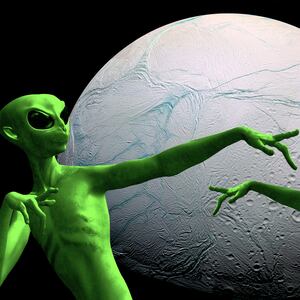The rings of Saturn are one of the most iconic structures in the solar system. Composed of billions of tiny chunks of ice and rock that are as small as dust and as large as a family home, the rings stretch to about 175,000 miles from the planet. Yet they are only about 30 feet in vertical thickness—paper thin in relation to a planet. And they orbit Saturn at a peculiar 26.7-degree tilt. Scientists still have no clue how these rings ended up here in the first place.
But a new modeling study run by MIT scientists suggests the origin story for the rings is a bit more gruesome—the violent death of an ancient moon, at the hands of Saturn.
Today’s Saturn is host to 83 moons. The new study, published Thursday in the journal Science, hypothesizes that for billions of years, the planet was home to an additional moon, called Chrysalis. The two bodies existed in harmony.
ADVERTISEMENT

A view of Saturn taken by the Hubble Space Telescope in 2019.
NASA, ESABut according to the new modeling constructed by the researchers, it seems that 160 million years ago, Chrysalis lost stability and found itself orbiting too close to Saturn. The planet’s massive gravitational forces pulled the moon apart, tearing it to shreds relatively quickly. The destruction of the moon was, in fact, powerful enough to sever the gravitational ties Saturn once had with Neptune and resulted in Saturn acquiring its characteristic tilt.
The remnants of Chrysalis likely plunged into Saturn. But the researchers think a fraction of those pieces may have remained in orbit and eventually broke into the small icy fragments that now make up Saturn’s massive rings.
Ultimately, the new study seems to explain not just why Saturn has a tilt but also why the rings are a fairly new phenomenon (previously estimated to be only about 100 million years old).
“Just like a butterfly’s chrysalis, this satellite was long dormant and suddenly became active, and the rings emerged,” Jack Wisdom, a planetary scientist at MIT and lead author of the new study, said in a press release.
The new modeling was made possible thanks to data collected by NASA’s Cassini probe in September 2017, during its final mission moments when it self-destructed in Saturn’s atmosphere. Those observations helped shed light on Saturn’s gravitational field and inertia, which helped reveal that Neptune and Saturn had once been gravitationally in sync with each other. The team sought to understand this history, and it led to some modeling that has finally proposed the existence of Chrysalis long ago.
“It’s a pretty good story,” said Wisdom. “Like any other result, it will have to be examined by others. But it seems that this lost satellite was just a chrysalis, waiting to have its instability.






